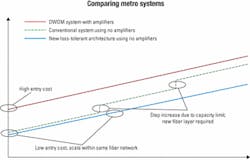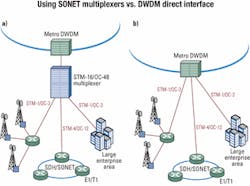Solving metro DWDM cost issues
Unamplified architecture solutions provide more efficient DWDM networks.
PATRIK VON MATERN, Lumentis AB
There is no other technology that can compete with DWDM in terms of capacity, scalability, and transparency. That is why DWDM-based systems have been the solution for both international and national long-haul (LH) networks for quite some time. This unmatched performance is being required more and more to solve the bandwidth bottlenecks also found in city networks-but still, metro DWDM networks are rare.
Why are there so few metro DWDM networks? What can be done to remove the obstacles preventing widespread deployment of DWDM-based networks in the metro? First, they must become more economically feasible, and the ability to build networks without optical amplifiers is one crucial starting point.
An additional way to lower the cost of employing DWDM in the metro is to eliminate the SONET/SDH layer in the network. By collapsing the layers in metro networks, less hardware and less interoperability are needed, leading to a more cost-effective, simplified network.
Why DWDM?So far, many metro operators and city carriers have built networks based on SONET/SDH technology, but as the customer channels are reaching and surpassing the capacity of the SONET/SDH subnetworks, operators must deal with some difficult consequences. They need, most likely, to upgrade the entire SONET/SDH network to a higher capacity, resulting in scrapping systems and making huge investments in new equipment.Further, there are a variety of traffic formats within the metro space that must be covered, including SAN formats like Escon, Ficon, Fiber Channel, and IP formats such as Gigabit Ethernet and 10-Gigabit Ethernet. The SONET/SDH technology is not designed for these formats, requiring carriers to build separate networks to carry them.
So an operator or city carrier requires multiple network technologies and a lot of old equipment that is quickly becoming obsolete. In addition, the fiber count available in cities is far from infinite. Stacking SONET/SDH rings or adding new point-to-point connections is not an option in many cases.
The idea of using DWDM-based solutions is obvious, but many operators have been turned off by the capital expense required. The conventional system architecture approach-used in LH networks-ends up being too costly and cannot fulfill all the specific characteristics of the metro environment.
Removing the long-haul legacy
Several vendors targeting the metro space with DWDM solutions have addressed some of the cost issues by expanding the capabilities of their conventional LH architectures into the metro. One obvious target is the optical amplifier (OA). Since the distances in the metro are short, the need for intermediate line amplifiers is no longer required.
As a result, the separate optical supervisory channel (OSC) wavelength channel necessary to reach these intermediate line amplifiers can be removed and replaced by embedded management solutions or using a local data communications network. The cost for these OSC add/drop filters is removed, together with the optical losses they introduce.
As a result, the ability to create metro networks without OAs has increased. But due to the inherent high optical losses of the conventional system architectures, in combination with the higher losses incurred in metro fiber networks, there is still a need for OAs to cover the capacity and network size requirements.A metro fiber network includes multiple optical distribution frames (ODFs), splices, and non-optimal fiber duct placements. That results in losses up to and in many cases above 0.8 dB/km. The OA is therefore difficult to remove, and the focus is shifting to reducing the costs for these devices.
New so-called metro amplifiers are emerging to address this issue. But even if the cost of the amplifier is reduced, a number of direct and indirect costs are still introduced for an operator. The ability to create unamplified networks with sufficient capacity is still of high interest, but it requires a new system architecture to achieve.
Other alternatives
In unamplified DWDM networks, there is a tradeoff between distance and number of wavelength channels. The available power budget is either used on path losses (fiber, ODFs, and splices) or on optical add/drop filters, optical multiplexers and demultiplexers, and other necessary elements.
As the loss limit is reached, an additional fiber pair must be acquired to enable the addition of more traffic. This loss limit is reached rather early for conventional unamplified architectures and limits the applications in which they can be used effectively. As a result, most metro networks today are solved with amplified solutions.
Coarse WDM (CWDM) is an unamplified technology that is being considered as a cheap alternative to DWDM. That conclusion, however, is dangerous. CWDM is focused on low cost, limited to 40 km and eight channels at maximum 2.5 Gbits/sec. Some vendors promise 16 wavelengths, but that will require new fiber types to avoid the higher attenuation in the additional wavelength bands necessary.
Trying to use CWDM-based systems outside their intended application can turn out to be considerably more expensive than a DWDM solution. Distances beyond 40 km will require cascading transponders. Wavelength counts above eight channels will require additional fiber, affecting the connectivity between the nodes. A future upgrade to 10 Gbits/sec is also out of the question. CWDM has its niche in metro covering the last few miles only.
What is the solution?
A unique, loss-tolerant DWDM architecture now exists on the market that enables unamplified DWDM networks to be deployed with a distance/capacity ratio that outperforms conventional architectures. Earlier this year, a third-party telecommunications test house proved the performance of this architecture with transmission and interoperability tests on a real fiber network.
The test results achieved using a 98-km ring with one hub node and 20 satellite nodes resulted in a 40-wavelength network. A conventional system would have reached the loss limit at eight wavelengths. Finally, the ability to create high-capacity networks without OAs is a substantial breakthrough, opening up opportunities for deployment of DWDM-based networks where they were previously not technically or economically feasible. By eliminating the OAs, several important advantages emerge that will be crucial to operators:
- Low initial network investment, then pay as you grow. OAs can represent more than 50% of the equipment cost when deploying the first channel. An unamplified network will provide a low initial capital expense-vital to ensure short time-to-revenue. New wavelength customers can be added with low cost and need not share any initial investments on expensive amplifiers.
- Easier wavelength management. All wavelengths are independent and can be added, removed, or rerouted without the need to compensate for existing channels via the complex power-level adjustments and channel- bal anc ing schemes required in amplified networks. That is especially important in metro networks where a high degree of flexibility is required.
- More reliable network. A failed OA can bring down the entire network, since it affects all wavelengths that pass through it. This single point of failure is removed.
- Lower lifecycle and operational cost. There is no need to stock costly spare amplifiers, and less skilled support personnel are required to deploy, provision, and configure the network.
- More nodes. OAs introduce optical noise, which will limit the number of nodes on a network and may prevent the creation of closed-ring structures.
Figure 1 compares the different DWDM system architectures from a cost-capacity perspective. Amplified solutions are burdened by the high initial cost, and conventional unamplified solutions are burdened by limited capacity. The new architecture combines the positive benefits of both.
To introduce a wider deployment of DWDM metro networks, the use of each wavelength is one important aspect that can be addressed by aggregating several traffic channels on a single wavelength. For example, let's assume a case where an operator has multiple OC-3/STM-1 (155-Mbit/sec) or OC-12/STM-4 (622-Mbit/sec) traffic chan nels to collect for transport up to a hub node on an existing metro DWDM network.
Two alternative solutions are shown in Figure 2. The conventional solution is to place a SONET/SDH multiplexer to aggregate those channels into an OC-48/STM-16 (2.5 Gbits/sec) traffic channel before placing them on a wavelength.
A more advantageous solution is to use a plug-in module for DWDM equipment that performs simple TDM aggregation of the tributary signals. The need for intermediate SONET/SDH equipment is therefore ruled out and considerable cost savings in equipment and operational costs are achieved.
This module enables transport of multiple SONET/SDH traffic channels using only one wavelength. Similar plug-in modules also exist for other traffic types like Gigabit Ethernet and provide direct interface to the DWDM network without the need for intermediate concentrators. The cost per traffic channel in the DWDM network is reduced, and investments in SONET/SDH multiplexers and IP routers are removed.
Loss-tolerant architecture
A broader deployment of DWDM-based network solutions in the metro environment requires a new approach to how these networks must be built more affordably for city carriers and metro operators. A loss-tolerant architecture that enables unamplified networks will provide solutions that use the network as efficiently as possible by eliminating multiple layers and providing a low entry and lifecycle cost for metro operators and city carriers. That will shorten the time-to-revenue and provide the operator with a powerful multiservice network that will cover current and future needs.
Patrik von Matern is director of product management at Lumentis AB (Stockholm). He can be reached via the company's Website, www.lumentis.se.


